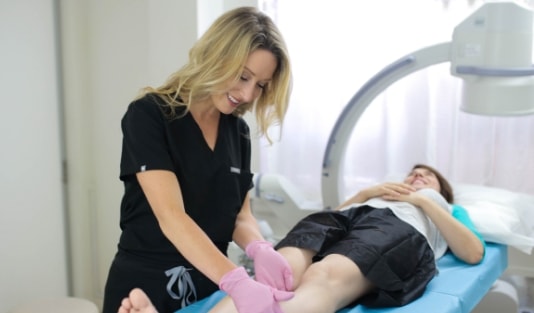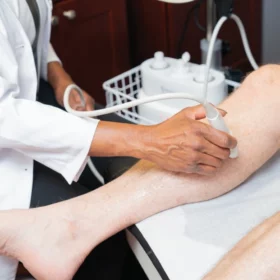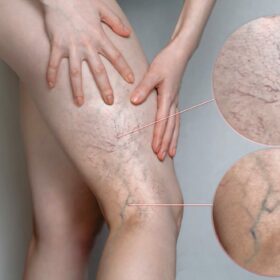If you’re considering vein treatment, you’ve come to the right place. At Vein Treatment Clinic, our board-certified vein doctors are dedicated to providing you with the highest quality care, starting from your initial consultation all the way through your recovery. In this comprehensive guide, we walk you through each step of the vein treatment consultation process, ensuring you feel informed, comfortable, and empowered to make the best decisions for your health.
Step 1: Scheduling Your Consultation
The first step in your vein treatment journey is scheduling a consultation with one of our experienced vein doctors. You can easily book an appointment by calling our clinic or filling out our online appointment request form. We understand that your time is valuable, so we offer flexible scheduling options to accommodate your busy lifestyle. Our scheduling team will work with you to find a convenient appointment time that fits your schedule.
Step 2: Preparing for Your Consultation
Before your consultation, there are a few things you can do to prepare. It’s helpful to compile a list of any symptoms you’re experiencing, such as pain, swelling, or visible veins. Additionally, jot down any questions or concerns you may have about your vein health or potential treatment options. If you have any relevant medical records or imaging results from previous appointments, be sure to bring them along to your consultation.
Here’s a checklist of everything you can do before your consultation:
- Compile a list of any symptoms you’re experiencing, such as pain, swelling, or visible veins.
- Note down any questions you have about your vein health or potential treatment options.
- Gather any relevant medical records or imaging results from previous appointments.
- Confirm the date and time of your consultation appointment and mark it on your calendar.
- Arrange for transportation to and from the clinic, especially if you anticipate undergoing any procedures that may affect your ability to drive.
- Wear comfortable clothing that allows easy access to the areas of concern on your legs for the physical examination.
- Bring a list of your current medications, including over-the-counter supplements, and inform your vein doctor of any allergies or sensitivities.
- Plan to arrive a few minutes early to complete any necessary paperwork and ensure a stress-free check-in process.
- Bring a notebook or electronic device to take notes during your consultation so you can reference them later if needed.
Step 3: Meeting Your Vein Doctor
During your consultation, you’ll have the opportunity to meet with one of our board-certified vein doctors, who will conduct a thorough evaluation of your veins. Our doctors are compassionate, knowledgeable, and committed to providing personalized care tailored to your unique needs. They will take the time to listen to your concerns, answer any questions you may have, and explain your treatment options in detail. Feel free to share any specific goals you have for your vein treatment, as this will help us tailor your treatment plan to meet your needs.
Step 4: Comprehensive Vein Evaluation
As part of your consultation, your vein doctor will perform a comprehensive evaluation of your vein health. This may include a physical examination as well as non-invasive imaging tests such as ultrasound. These tests will help your doctor assess the cause of your vein issues, whether it’s varicose veins or venous insufficiency. By diagnosing your condition, our vein doctors can develop a treatment plan to address your specific concerns and provide long-lasting relief.
Step 5: Discussion of Treatment Options
Once your vein doctor has completed your evaluation, they will discuss your treatment options in detail. At Vein Treatment Clinic, we offer a variety of minimally invasive vein treatments, including sclerotherapy, endovenous laser therapy (EVLT), and ambulatory phlebectomy. Your doctor will explain each treatment, including how it works, the expected outcomes, and any potential risks or side effects. They will also take into account your preferences and lifestyle factors to help you make an informed decision.
Step 6: Developing Your Treatment Plan
Based on your consultation and evaluation, your vein doctor will develop a personalized treatment plan that aligns with your goals and preferences. This may involve a combination of treatments tailored to address your specific vein issues and achieve the best possible results. Your doctor will explain the recommended treatment plan in detail, including what to expect before, during, and after each procedure. They will also answer any questions you may have and ensure that you feel comfortable and confident moving forward with your treatment.
Depending on your specific condition, your vein treatment plan may include:
- Endovenous Laser Ablation (EVLA): EVLA is a highly effective procedure used to treat larger varicose veins and underlying venous reflux. During this minimally invasive treatment, a thin laser fiber is inserted into the affected vein, where it delivers targeted energy to seal the vein shut. Over time, the closed vein is absorbed by the body, leading to improved blood flow.
- Radiofrequency Ablation (RFA): Similar to EVLA, RFA is a minimally invasive procedure that uses radiofrequency energy to heat and close off diseased veins. By generating controlled heat, RFA causes the vein walls to collapse and eventually be reabsorbed by the body. This technique is particularly effective for treating venous reflux and varicose veins.
- VenaSeal: VenaSeal is a revolutionary vein treatment that utilizes medical adhesive to seal off diseased veins. During the procedure, a small amount of adhesive is injected directly into the targeted vein, causing it to close and reroute blood flow to healthier veins. VenaSeal offers the advantage of being needle-free and requires no tumescent anesthesia.
- ClariVein: ClariVein is a catheter-based treatment that effectively treats varicose veins by combining mechanical agitation with sclerosant injection. A rotating wire within the catheter disperses a sclerosant solution throughout the vein, causing it to collapse and eventually fade from view. ClariVein is virtually painless and requires no tumescent anesthesia.
- Ambulatory Phlebectomy: Ambulatory phlebectomy is performed to remove superficial varicose veins through tiny incisions in the skin. This procedure is typically performed under local anesthesia and allows for the precise removal of bulging veins. Ambulatory phlebectomy is often combined with other vein treatments to achieve comprehensive results.
- Sclerotherapy: Sclerotherapy is a versatile treatment option for spider veins and small varicose veins. During the procedure, a sclerosant solution is injected directly into the affected veins, causing them to collapse and fade from view over time. Sclerotherapy is a quick and relatively painless procedure that can be performed in the office with little to no downtime.
Step 7: Scheduling Your Treatment
Once you and your vein doctor have finalized your treatment plan, our staff will assist you in scheduling your treatment appointments. We understand that undergoing medical procedures can be intimidating, which is why we strive to make the process as smooth and stress-free as possible. Our team will work with you to find appointment times that fit your schedule and ensure that you have all the information you need to prepare for your treatment.
Step 8: Preparing for Your Treatment
Before your treatment, your vein doctor will provide you with detailed instructions on how to prepare. This may include guidelines on medications to avoid, what to eat and drink, and any other pre-operative steps you need to take. It’s important to follow these instructions carefully to ensure the best possible outcome from your treatment. If you have any questions or concerns about preparing for your treatment, don’t hesitate to reach out to our clinic for assistance.
Step 9: Undergoing Your Treatment
On the day of your treatment, you can expect to receive compassionate care from our medical team. Depending on the type of procedure, your treatment may take anywhere from 30 minutes to an hour to complete. Our minimally invasive techniques allow for quick recovery times and minimal discomfort so you can get back to your daily activities as soon as possible. During your treatment, our staff will ensure you are comfortable every step of the way.
Step 10: Post-Treatment Care and Follow-Up
After your treatment, your vein doctor will provide detailed instructions on post-operative care and recovery. This may include wearing compression stockings, avoiding strenuous activity, and scheduling follow-ups to monitor your progress. Our team is committed to supporting you throughout your recovery and ensuring you achieve the best possible results from your treatment. If you have any questions, reach out to our clinic for guidance and support.
Schedule Your Vein Treatment Consultation
At Vein Treatment Clinic, we understand that seeking treatment for vein issues can be overwhelming, but you don’t have to face it alone. Our team of vein doctors and staff is here to guide you through every step of the consultation process, from your initial appointment to your post-treatment follow-up. Contact us today to schedule your consultation.












